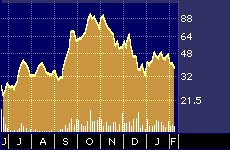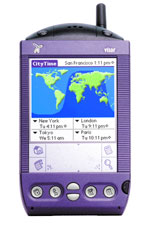
Can Handspring Beat The Odds?
Can Handspring Beat The Odds?

By Hal Plotkin
CNBC.com Silicon Valley Correspondent
Feb 12, 2001 08:37 AM
Several analysts have been pounding the table hard on Handspring Inc.’s {HAND} stock lately. For tech investors, they say, HAND is the perfect antidote to the personal-computer blahs. While growth in PC sales dipped into single digits last year, the market for handheld personal digital assistants (PDAs) such as those made by Handspring soared by 161%, according to the Giga Information Group.
Handspring seems well positioned to continue to ride the PDA wave. After all, Handspring’s founders — the people who brought you the Palm while employed at 3Com Corp. {COMS} — essentially created the PDA industry. Hence the table pounding for HAND, which is currently trading roughly 60 percent off its 52-week high.
But more cautious investors should know that when it comes to the next year or so, expert opinions are pretty sharply divided about whether the PDA industry can sustain its recent growth rate.

One-year performance of HAND
In particular, if you’re counting on a rapid rollout of new wireless applications to keep sales of handheld personal digital assistants such as Handspring’s Visor booming, you could be in for a big disappointment. Furthermore, the industry also hasn’t yet settled on a common standard for add-on modules, another factor that could slow down customer acceptance of new applications, at least over the short-term.
That said, Handspring is easily one of Silicon Valley’s most impressive and promising young high tech firms. Beyond technology, the company’s most important assets may be its founders, Jeff Hawkins and Donna Dubinsky, who led the effort to create the Palm Pilot at 3Com Corp. {COMS} before jumping ship to found Handspring in 1998. Handspring went public in late June 2000 with shares initially priced at $20 each.
Last week, C.E. Unterberg, Towbin analyst Jason Tsai put out an unusually thorough and detailed research report initiating coverage of Handspring’s stock with a buy recommendation and a $62 12-month price target.
“By our estimates, Handspring captured 11%, or 1.2 million units, of the global CY2000 handheld computer market…from a standing start,” Tsai wrote. “While this market will become crowded quickly, we expect the company to continue to grow faster than the industry as a whole, based on a superior product development effort.”
Handspring’s ever-growing legion of competitors includes its since birthmother, Palm Inc. {PALM}, since spun off from 3Com, which, according to Giga Information Group, holds 70% to 75% of the consumer PDA market and 40% to 55% of the market for PDAs sold to business. In addition, Handspring is now scrapping with a growing list of PDA makers including Sony Corp. {SNE} and Compaq Computer Corp. {CPQ} for the rest of the pie.
Analysts still think Handspring can be a standout in this crowd, partly because of its easy-to-use Springboard technology, a format that allows users to plug in small application-specific hardware modules. Handspring claims over eight thousand independent high-tech firms are developing add-ons for the Visor, a number dwarfed only by Palm’s even more astonishing claim of 43,000 active application development partners.

The Handspring VisorPhone
The first of these products, VisorPhone, was introduced last quarter and let Handspring owners turn their PDAs into mobile phones. The expectation is that future add-on modules will open up a wide variety of new market opportunities including everything from mobile games, wireless cash that can be sent directly from a PDA to a cash register, and lucrative enterprise market solutions designed for a single company or industry.
Other PDA manufacturers also have add-on capabilities but, similar to the Sony Betamax vs. VHS standards war fought out over videotape technology two decades ago, there is no agreement yet within the industry on a single add-on standard. If the history of the personal computer is any guide, it was the establishment of hardware and software standards that were originally set down by one company, in that case IBM Corp., that finally spurred the rapid growth that led thousands of small companies to build new hardware and programs adapting the PC to all sorts of uses.
The SD add-on technology Palm has chosen has also been embraced by Toshiba, which plans to include SD ports in forthcoming laptop computers. Several large cell phone makers are also considering including the postage-stamp SD ports, according to industry sources. Sony’s Clie’ PDA, meanwhile, uses the company’s proprietary Memory Stick add-on technology.
Handspring’s backers like the fact that Handspring’s Springboard technology allows a developer to make a conversion device that accommodates all future SD add-on devices. That means Handspring owners should be able to use all the add-on features that will become available for the Palm, but not vice-versa.
“You’ll probably be able to use the SD devices on a Handspring before you will be able to use them on a Palm,” says Thomas Sepenzis, an analyst at CIBC World Markets Corp., based in San Francisco. “It’s a brilliant strategy.”
Spenzis currently has a strong buy rating on Handspring’s stock along with a $90 12-month price target.
But some analysts fear that Springboard won’t survive the format war. Most likely, only one format will prevail and betting wrong could be costly for investors.
“SD will have much more acceptance than Springboard,” predicts Kevin Burden, an analyst at International Data Corp. based in Framingham, Massachusetts. “There is a limit to how small you can make the Handspring Visor if it has to support Springboard. Right now, Springboard is the reason you buy Handspring. But longer range, you’ve got to look where the market is heading. I think we’ll see a lot more vendors supporting SD than Springboard because SD is smaller.”
People want devices they can stuff in their shirt pocket or purse, says Burden. He says that when it comes to consumer electronics, size matters, with victory often going to the smallest device in each category that gets the job done.
The other uncertainty confronting Handspring and its competitors is how long it will take before new practical wireless PDA applications take off.
Last year, sales of PDA’s exploded, growing to an estimated 10.9 million units. The growth was driven, analysts say, mostly by consumers who wanted to use the PDA’s for their original purposes, such as storing addresses, calendars, and contact lists.
The betting now, however, is that most consumers who wanted a PDA for such purposes already have one and that new applications, particularly new wireless applications, will be required before total PDA sales approach the volumes needed to assure more dependable returns to investors.
Jupiter Media Metrix, for example, forecasts that the installed base of PDA’s used for real-time web browsing will grow from an estimated 250,000 last year to just 700,000 by the end of 2001.
“The next few years we’re not talking huge money,” says Seamus McAteer, an analyst for Jupiter Media Metrix. “But the subscription fees are not chump change and the margins are pretty nice.”
Most analysts agree, however, that the real inflection point for new wireless PDA applications will come sometime in or around late 2002, when wireless carriers begin offering services with enough bandwidth, or carrying capacity, to make the handheld PDAs perform more like their desktop hardwired predecessors.
“I find it hard to believe [the PDA market] will grow as fast in 2001 as it did in 2000,” says Ken Smiley, an analyst at the Giga Information Group. “If you’re buying PDA stocks for that reason, you’re buying them for the wrong reason.”
C.E. Unterberg, Towbin’s analyst Tsai, on the other hand, says he bases his higher price target for Handspring’s stock on an expectation of better bottom line performance coming from higher end products with faster microprocessors and color screens which will make it even easier to turn the Handspring Visor into an MP3 player, a digital camera, a phone or a paging device.
It remains to be seen, however, whether adapted PDAs will be competitive with the best MP3 players, cameras, and cell phones.
Tsai says Handspring should eventually be able to generate more substantial recurring revenue from new wireless applications, but like the other analysts he’s pretty sure that won’t happen for at least another year or so.


